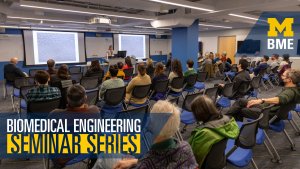Presented By: Biomedical Engineering
Biomedical Engineering Seminar Series
Real-time Modeling with Adaptive Interventions featuring Anne Draelos, PhD

Abstract:
Systems neuroscience is now tackling higher-dimensional spaces as we record from larger neural populations, examine richer behavioral repertoires, and place animals in more complex environments. Combined with precise stimulation technologies, we can begin to dissect large-scale circuits in vivo, constructing models that causally relate neural activity to behavior. Perturbative testing of hypothesized brain-behavior links, however, requires statistically efficient methods for both estimating and intervening on neural activity in real time. Here I will discuss a few ways in which we can construct and refine models built in real-time, as neural or behavioral data are acquired, and use them to ‘close the loop’ and determine the optimal next stimulus to present or optimal next neuronal perturbation to apply. We demonstrate these methods in simulation and in experiments studying the optomotor response in larval zebrafish with calcium fluorescence imaging.
Bio:
Dr. Anne Draelos is an Assistant Professor in Biomedical Engineering and Computational Medicine & Bioinformatics at the University of Michigan. Her lab is focused on machine learning and statistical techniques to facilitate real-time analysis of high-dimensional neural and behavioral data. Anne obtained her PhD in physics and underwent postdoctoral training in neuroscience at Duke University. She currently holds a Career Award at the Scientific Interface from the Burroughs Wellcome Fund.
Systems neuroscience is now tackling higher-dimensional spaces as we record from larger neural populations, examine richer behavioral repertoires, and place animals in more complex environments. Combined with precise stimulation technologies, we can begin to dissect large-scale circuits in vivo, constructing models that causally relate neural activity to behavior. Perturbative testing of hypothesized brain-behavior links, however, requires statistically efficient methods for both estimating and intervening on neural activity in real time. Here I will discuss a few ways in which we can construct and refine models built in real-time, as neural or behavioral data are acquired, and use them to ‘close the loop’ and determine the optimal next stimulus to present or optimal next neuronal perturbation to apply. We demonstrate these methods in simulation and in experiments studying the optomotor response in larval zebrafish with calcium fluorescence imaging.
Bio:
Dr. Anne Draelos is an Assistant Professor in Biomedical Engineering and Computational Medicine & Bioinformatics at the University of Michigan. Her lab is focused on machine learning and statistical techniques to facilitate real-time analysis of high-dimensional neural and behavioral data. Anne obtained her PhD in physics and underwent postdoctoral training in neuroscience at Duke University. She currently holds a Career Award at the Scientific Interface from the Burroughs Wellcome Fund.